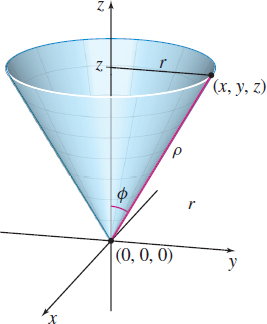EXAMPLE 5Parametrizing a Cone Using Different Coordinate Systems
Find a parametrization of the surface S defined by the cone z=√3x2+3y2x2+y2≤16
- (a) Using rectangular coordinates.
- (b) Using cylindrical coordinates.
- (c) Using spherical coordinates.
Solution (a) The equation is given in rectangular coordinates and is written explicitly as a function z=f(x,y). So, we define x=u, y=v, z=√3u2+3v2. Then a parametrization of the cone is r(u,v)=ui+vj+√3u2+3v2ku2+v2≤16
Cylindrical coordinates are discussed in Section 14.7, pp. 950-954.
(b) In cylindrical coordinates, the cone is given by z=√3x2+3y2=√3√(rcosθ)2+(rsinθ)2=√3√r2=√3r
where z is expressed explicitly in terms of r and θ. So if we use r and θ as parameters, then a parametrization of the cone is r(r,θ)=rcosθi+rsinθj↑x=rcosθ,y=rsinθ,z=√3r+√3rk0≤r≤40≤θ≤2π
(c) In spherical coordinates, the equation of a half cone, where z≥0, is ϕ=a, 0<a<π2. We use Figure 45 to find a. tanϕ=rz=r√3r=1√3z=√3rϕ=tan−11√3=π6=a
Using ρ and θ as parameters, parametric equations for the cone in spherical coordinates are x=↑sinπ6=12ρ2cosθy=↑sinπ6=12ρ2sinθz=↑cosπ6=√32√32ρ
Now we find the parameter domain. Since z2=3x2+3y2 and ρ2=x2+y2+z2=x2+y2+(3x2+3y2⏟z2)=4x2+4y2
we have 0≤ρ2=4(x2+y2)≤4⋅16=64, or equivalently, 0≤ρ≤8.
The parameter domain of the cone is 0≤ρ≤8 and 0≤θ≤2π. Then a parametrization of the cone is r(ρ,θ)=ρ2cosθi+ρ2sinθj+√32ρk0≤ρ≤80≤θ≤2π
